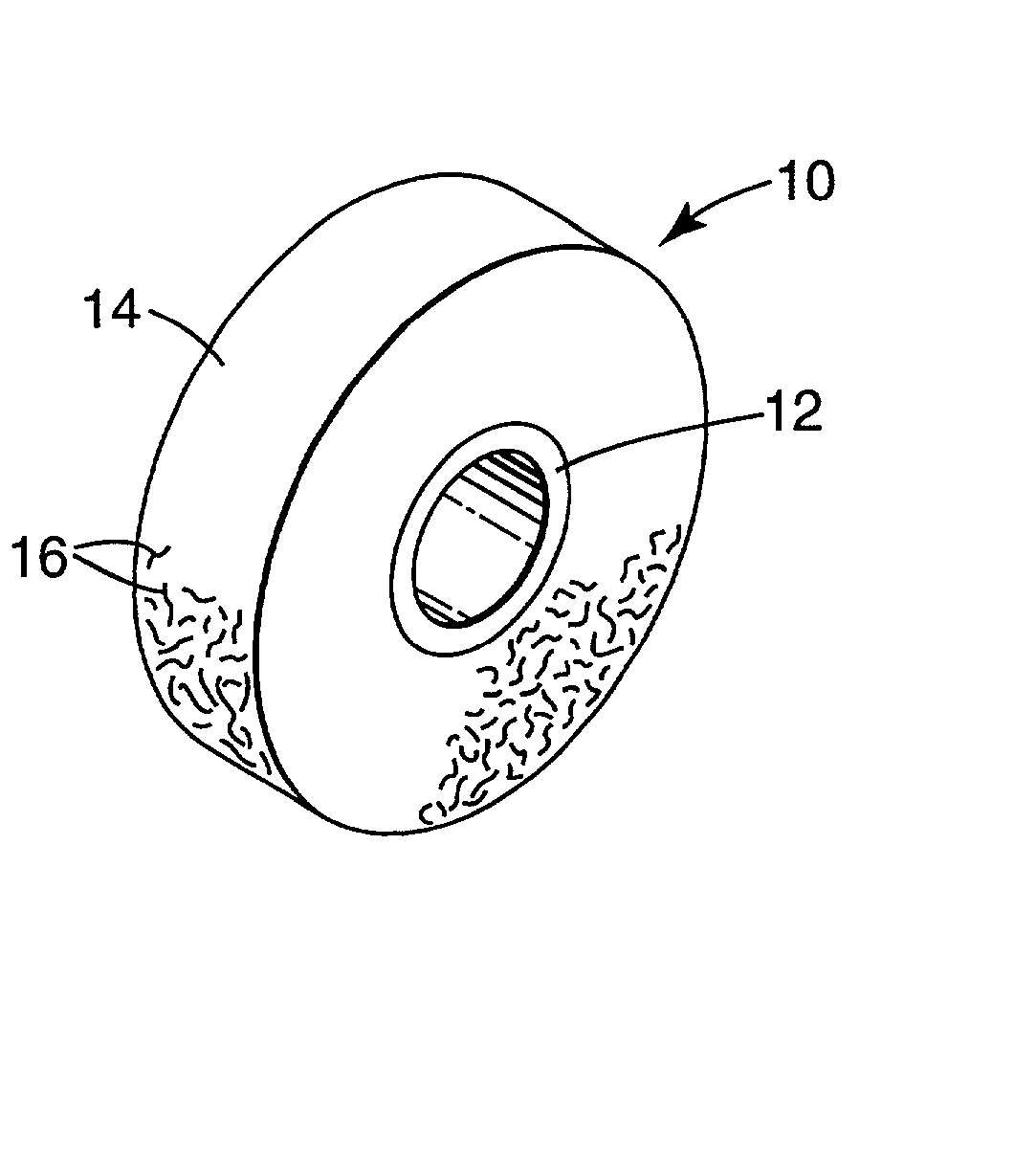Cellular abrasive article
a technology of abrasives and articles, applied in the field of cellular abrasives, can solve the problems of fragments of abrasive articles softening, current cellular or foam abrasives do not provide the desired level of each of these features,
- Summary
- Abstract
- Description
- Claims
- Application Information
AI Technical Summary
Benefits of technology
Problems solved by technology
Method used
Image
Examples
example 1
[0077] An abrasive wheel was made as follows. A mixture was prepared by combining 80 grams of a preformulated saturated polyol (obtained under the trade designation "MILLOXANE 7209A" from Polyurethane Specialties Company Inc, Lyndhurst, N.J.) and 4.8 grams of finely divided lithium stearate lubricant. The mixture was stirred vigorously at high speed with a conventional laboratory three blade, air motor mixer.
[0078] When the lithium stearate was well dispersed, 80 grams of a preformulated saturated polyisocyanate (obtained under the trade designation "MILLOXANE 7209B" from Polyurethane Specialties Company Inc, Lyndhurst, N.J.) was added to the mixture without stirring; followed by 440 grams of abrasive agglomerate particles. The agglomerates were generally prepared as described in co-pending application having U.S. Ser. No. 09 / 688,444, filed Oct. 16, 2000, the disclosure of which is incorporated herein by reference.
[0079] More specifically, the abrasive agglomerates were prepared by ...
example 2
[0084] The Example 2 abrasive wheel was prepared as described in Example 1 except that the abrasive agglomerate particles were prepared using a conical forming screen with 1.91 mm (0.075 inch) circular openings. The abrasive agglomerate particles were about 1.3 cm (1 / 2 inch) long. The resulting abrasive wheel was 2.5 cm (1 inch) thick, and had an inside diameter of 7.6 cm (3 inches) and an outside diameter of 20.6 cm (8.125 inches). The abrasive wheel weighed 634 grams, had a AG / P ratio of 2.75, a density of 0.82 g / cm.sup.3 (13.4 g / in.sup.3), a Shore A durometer value of 30-50, and a void volume of 62.4%. The wheel was prepared for evaluation by first dressing the working surface of the wheels with an abrasive tool to remove the surface skin of the wheel.
example 3
[0085] The Example 3 abrasive wheel was prepared as described in Example 1 except that the abrasive agglomerate particles were prepared using a conical forming screen with 1.91 mm (0.075 inch) circular openings, no lithium stearate lubricant was added, no fiberglass core was used, and no knit scrim was used. Further, the mixture was prepared using 109 grams of the preformulated saturated polyol ("MILLOXANE 7209A"), 109 grams of the preformulated saturated polyisocyanate ("MILLOXANE 7209B"), and 444 grams of the abrasive agglomerate particles. The abrasive agglomerate particles were about 1.3 cm (1 / 2 inch) long.
[0086] The resulting abrasive wheel was 2.5 cm (1 inch) thick, and had an inside diameter of 7.6 cm (3 inches) and an outside diameter of 20.6 cm (8.125 inches). The abrasive wheel weighed 552 grams, had a AG / P ratio of 2.04, a density of 0.67 g / cm.sup.3 (10.9 g / in.sup.3), a Shore A durometer value of 30-50, and a void volume of 67.4%.
[0087] The wheel was prepared for evaluati...
PUM
| Property | Measurement | Unit |
|---|---|---|
| Length | aaaaa | aaaaa |
| Length | aaaaa | aaaaa |
| Length | aaaaa | aaaaa |
Abstract
Description
Claims
Application Information
 Login to View More
Login to View More - R&D
- Intellectual Property
- Life Sciences
- Materials
- Tech Scout
- Unparalleled Data Quality
- Higher Quality Content
- 60% Fewer Hallucinations
Browse by: Latest US Patents, China's latest patents, Technical Efficacy Thesaurus, Application Domain, Technology Topic, Popular Technical Reports.
© 2025 PatSnap. All rights reserved.Legal|Privacy policy|Modern Slavery Act Transparency Statement|Sitemap|About US| Contact US: help@patsnap.com



